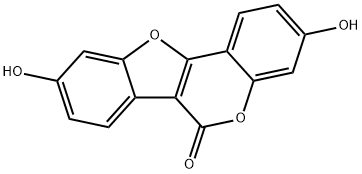479-13-0
 479-13-0 結(jié)構(gòu)式
479-13-0 結(jié)構(gòu)式
基本信息
擬雌內(nèi)酯
香豆雌酚
2-(2,4-DIHYDROXYPHENYL)-6-HYDROXY-3-BENZOFURANCARBOXYLIC ACID DELTA-LACTONE
2-(2 4-DIHYDROXYPHENYL)-6-HYDROXY-3-BENZOFURANCARBOXYLIC ACID D-LACTONE
3,9-DIHYDROXY-6H-BENZOFURO[3,2-C]-[1]BENZOPYRAN-6-ONE
7,12-DIHYDROXYCOUMESTAN
7,12-DIHYDROXYCOUMESTANE
7(1), 6-DIHYDROXYCOUMARINO(3(1), 4(1), 3,2)COUMARONE
COUMESTROL
2-(2,4-dihydroxyphenyl)-6-hydroxy-3-benzofurancarboxylicacidelta-lacton
2-c)(1)benzopyran-6-one,3,9-dihydroxy-6h-benzofuro(
2-c][1]benzopyran-6-one,3,9-dihydroxy-6h-benzofuro[
cumoesterol
Coumesterol
COUMESTROL(P)
COUMOESTROL
7 12-DIHYDROXYCOUMESTAN 98%
2-(2 4-DIHYDROXYPHENYL)-6-HYDROXY-3-BENZOFURANCARBOXYLIC ACID D-LACTONE 98%
物理化學(xué)性質(zhì)
安全數(shù)據(jù)
常見問題列表
IC50: 50 μM
Coumestrol exerts chemotherapeutic effects via PI3K and ERK1/2 MAPK pathways. Coumestrol inhibits viability and invasion, and induces apoptosis of ES2 (clear cell-/serous carcinoma origin) cells. In addition, immunoreactive PCNA and ERBB2, markers of proliferation of ovarian carcinoma, are attenuated in their expression in coumestrol-induced death of ES2 cells. Phosphorylation of AKT, p70S6K, ERK1/2, JNK1/2 and p90RSK is inactivated by coumestrol treatment in a dose- and time-dependent manner. Coumestrol inhibits proliferation and induces apoptosis in MCF-7 cells, which is prevented by copper chelator neocuproine and ROS scavengers. Coumestrol treatment induces ROS generation coupled to DNA fragmentation, up-regulation of p53/p21, cell cycle arrest at G1/S phase, mitochondrial membrane depolarization and caspases 9/3 activation.
